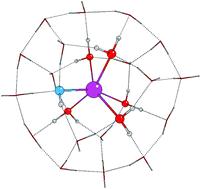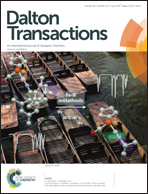The importance of second shell effects in the simulation of hydrated Sr2+ hydroxide complexes†
Abstract
Density functional theory at the meta-GGA level is employed to study the microsolvation of Sr2+ hydroxides, in order to establish likely candidate species for the interaction of nuclear fission-generated strontium with corroded Magnox fuel cladding in high pH spent nuclear fuel storage ponds. A combination of the COSMO continuum solvation model and one or two shells of explicit water molecules is employed. Inclusion of only a single explicit solvation shell is unsatisfactory; open regions are present in the strontium coordination shell which would not exist in real aqueous complexes, and many optimised structures possess unavoidable energetic instabilities. Incorporation of a second shell of explicit waters, however, yields energetically minimal structures without open regions in the first strontium coordination shell. The most stable systems with one, two or three hydroxide ions are all 6-coordinated with a distorted trigonal antiprismatic geometry, whereas systems with four OH− ions have a most stable coordination number of five. Transformation, via a proton transfer mechanism, from one coordination mode to another (e.g. from a system with two hydroxides bound directly to the strontium to one in which a hydroxide ion migrates into the second coordination shell) is found to be energetically facile. It is concluded that the most likely strontium-hydroxide complexes to be found in high pH aqueous solutions are mono- and dihydroxides, and that these coexist.


 Please wait while we load your content...
Please wait while we load your content...